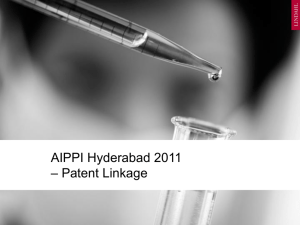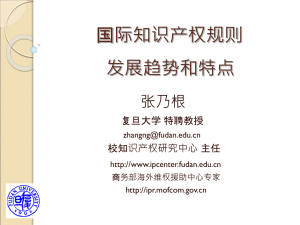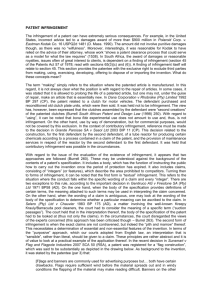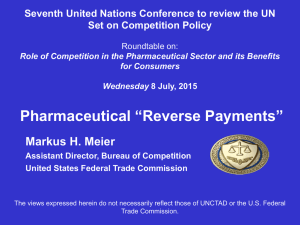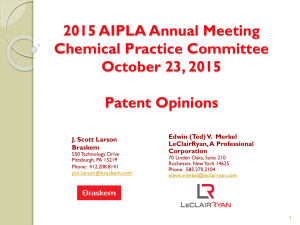no longer a real dispute - Competition Law Association
advertisement
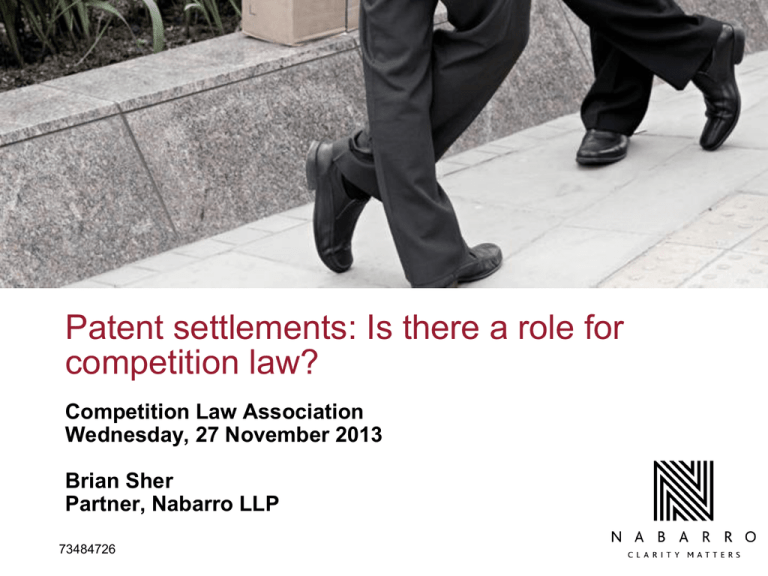
Patent settlements: Is there a role for competition law? Competition Law Association Wednesday, 27 November 2013 Brian Sher Partner, Nabarro LLP 73484726 Points to cover 1. 2. 3. 4. Core elements of European regulators’ theory of harm – recap Stylised theory vs reality Selected legal issues arising Authorised generic supply agreements 1. Core elements of European regulators’ theory of harm • Patent settlements involving… Transfer of value + In return for restrictions on entry = Object infringement • Compromise on entry date (without payment) deemed acceptable Compromise entry date T T + 16 (say) 2. Stylised competition regulatory view vs reality • Commission claims to be condemning only type B2 (value + restriction) settlements – but reality of most type A (no restriction) and type B1 (no value to originator) settlements is that there is no longer a real dispute – Category A – consistently c.70% - no value transfer either – “walk away” settlements (3rd Monitoring report paras 32,36) – Category B1 – in majority of cases generic agreed to enter only after patent expiry – “main characteristic.. seems to be that in the assessment of the parties the originator company had a strong case” (para 39) Stylised regulatory view v reality, contd. • Contrast - what a real dispute looks like: – Views on validity / infringement may differ within organisations and over time – Complexity, even for expert patent judges – Imbalance of risks / rewards for originators vs generics – Huge investment associated with patent protected medicine (detailing staff, plant) – quite apart from R&D costs recouped over patent period • Consequences: sense/legitimacy in settlement; payments can bridge gaps 3. Selected legal issues: (a) potential competitors (PC) • Jurisdictional criterion • Legal test: “real concrete possibilities” – European Night Services; E.On v Ruhrgas • Disagreement is in application: – Fundamental problem for competition authorities – presence of patents (blocking position) + lack of competence to assess validity / infringement – Competition authorities view litigation / challenges as part of competitive process - but litigation determines whether PC – Competition authorities focus on efforts to develop / find noninfringing source; preparatory steps; intent / commitment – but none of that goes to objective ability – Compound patent vs formulation patents – “Clearing the way” Selected legal issues: (b) value • Competition authorities focus on value moving from originator to generic firm • But analysis is inconsistent, e.g: – Why does compromise on entry date not also involve value? – What about value to originator of avoiding risk of substantial damage associated with loss, releasing cross-undertaking in damages? Value to both parties in ending the litigation? Selected legal issues: (c) restrictions on entry • Restriction on entry derives from the patent • Essence of settlement • In final injunctions courts prohibit apprehended infringement, not just infringing product at issue • Settlements have to be workable (can’t redefine the point at issue – whether patent infringed) • Real issue should be whether tailored to resolve the (genuine) dispute 4. Authorised generic supply agreements • Settlement may involve (immediate) supply of product to generic firm, enabling early (authorised) entry • Viewed as species of “value transfer” by Commission • But likely to reduce prices for consumers (empirical) • By definition that value for consumers will be more immediate than any (deferred) compromise on entry date agreement – Possible to analyse where compromise on entry date would have to be for that kind of agreement to be better for consumers – and whether such date is realistic – Would be absurd to suggest this should be in the “object” box
